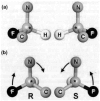The significance of chirality in drug design and development
- PMID: 21291399
- PMCID: PMC5765859
- DOI: 10.2174/156802611795165098
The significance of chirality in drug design and development
Abstract
Proteins are often enantioselective towards their binding partners. When designing small molecules to interact with these targets, one should consider stereoselectivity. As considerations for exploring structure space evolve, chirality is increasingly important. Binding affinity for a chiral drug can differ for diastereomers and between enantiomers. For the virtual screening and computational design stage of drug development, this problem can be compounded by incomplete stereochemical information in structure libraries leading to a "coin toss" as to whether or not the "ideal" chiral structure is present. Creating every stereoisomer for each chiral compound in a structure library leads to an exponential increase in the number of structures resulting in potentially unmanageable file sizes and screening times. Therefore, only key chiral structures, enantiomeric pairs based on relative stereochemistry need be included, and lead to a compromise between exploration of chemical space and maintaining manageable libraries. In clinical environments, enantiomers of chiral drugs can have reduced, no, or even deleterious effects. This underscores the need to avoid mixtures of compounds and focus on chiral synthesis. Governmental regulations emphasizing the need to monitor chirality in drug development have increased. The United States Food and Drug Administration issued guidelines and policies in 1992 concerning the development of chiral compounds. These guidelines require that absolute stereochemistry be known for compounds with chiral centers and that this information should be established early in drug development in order that the analysis can be considered valid. From exploration of structure space to governmental regulations it is clear that the question of chirality in drug design is of vital importance.
Figures




References
-
- Grant MA. Protein structure prediction in structure-based ligand design and virtual screening. Comb Chem High Throughput Screen. 2009;72(10):940–960. - PubMed
-
- Administration F.a.D. Development of new stereoisomeric drugs. 2005 Jul 6; [cited 2010 April 23]; www.fda.gov/Drugs/GuidanceComplianceRegulatorylnformation/Guidances/ucm1....
-
- Nic M, Jirat J, Kosata B. IUPAC Gold Book Compendium of chemical terminology. 2005 [cited 2010 April 26]; http://goldbook.iupac.org.
-
- Caldwell J, Wainer IW. Stereochemistry: definitions and a note on nomenclature. Hum Psvchopharmacol. 2001;16(S2):SI05–S107. - PubMed
Publication types
MeSH terms
Grants and funding
LinkOut - more resources
Full Text Sources
Other Literature Sources
Research Materials

